I do! As an infantry soldier in Vietnam, C-Rations was my sole source of nourishment for at least 300 of the 365 days I served in-country.
When out on missions, infantry units were re-supplied with food, water, ammunition, clothes and other items by helicopter every three to five days. Cases of C-Rations are assigned and split among a squad of soldiers – there’s an ample supply to cover three meals per person – 4.5 pounds of canned wet food for each day’s adequate nourishment. However, none of us wanted to carry that much extra weight on our backs, instead, most settling for a single complete meal per day and extra cans of crackers, cakes and fruit to supplement their diet until the next resupply – all stuffed into a sock and tied to the back of a rucksack.
C-Rations are commercially prepared meals, used in the field and at times when hot meals were not available. These meals came in a case containing 12 meals. Each meal was in it’s own cardboard box, which contained the individual items sealed in cans. A can opener (called both a “John Wayne” or a “P-38”) was needed to open the cans.
The accessory pack with each meal was sealed in a foil pouch.
Some of the meals weren’t too bad, especially if somebody from home sent Heinz-57 Sauce or Hot Sauce to doctor them up.
Others were downright awful (Ham and Lima beans) and passed over – left behind for the Cherries when it is their turn to pick out meals. In an effort to keep things fair, I’ve witnessed squad leaders dumping cases of C-Rations upside down (hiding the name of the meal) and mixing them up to give everyone an equal chance of selecting a popular meal. Not sure how the armor units split their meals. I can only remember seeing cases of C-Rations stacked inside APC’s along with several five-gallon containers of water when we came upon them in the jungle.
I remember having to eat my C-Ration meal cold because we were either on the move or rushed to leave in the mornings. Honestly, the scrambled egg chunks or beans and weenies weren’t bad cold, but the rest needed to be heated in order to be palatable. Heating the meals and water required a small stove (see article below) with Sterno tabs or C-4 plastic explosive, the later burning very hot and fast – preferred for quick meals. The C-4 was safe to use as long as it wasn’t compressed or using too much at one time.
The popular meals and cans of pound cake, peaches and fruit cocktail were prized and worth their weight in gold – many soldiers hoarding them to barter for items during evening chow breaks; only one of each are included in every case of meals.
All individual empty cans and trash were buried prior to leaving the “table” – unless he had another use for one of the cans.
Coffee, tea and hot chocolate were plentiful and everyone had a stash. The dilemma here is that water is required for these and at almost three pounds per quart; the extra weight is a consideration. We already carried 4 – 5 quart canteens to keep hydrated until the next resupply. During the monsoon season or in areas with rivers and streams, this is a moot point as water is plentiful!
As I recall, only about 30% of the soldiers in my platoon did not smoke. Every C-Ration meal contained a single four-pack of cigarettes; ten different brands were primarily offered, but like the meals, some were more popular than others. If somebody liked Lucky Strikes, Parliament, Chesterfields or Pall Mall’s, they would never run out. The popular brands like Winston, Marlboro, Kools and Salem were always in short supply and benefited the non-smokers who used them to barter.
Division base camps and some larger firebases had staffed mess halls, serving three hot meals every day. The line units were pulled out of the field on occasion, usually about once a month for three days, to enjoy “home cooking”, barbecues and ice-cold beer and soda – a reward we always looked forward to.
Forgot to mention earlier that battalion sometimes surprises us during resupply and brings out hot food in thermos containers. The menu is comprised of one meat (meatloaf, beef tips, chicken, etc), mashed potatoes, veggies, cake or pie, ice-cold milk, lemonade and steaming, hot coffee.
There was always enough for seconds, but most of us passed as our shrunken stomachs have already overextended from a single helping of this gourmet meal. The Army also sends out a Sundries Pack or SP for each platoon, containing writing paper, envelopes, blue ink pens, foot powder, toothbrushes and paste, chewing gum, m&m’s, Hershey bars, Almond Joy, Mounds, Three Musketeers, Snickers and assorted cartons of cigarettes – providing us with many of the simple articles that helped make life a little easier. One SP was intended to meet the requirements of 100 men for one day, but we usually saw one SP per platoon (30 men) every two to three weeks. The Red Cross also distributed letters from school children, church groups and others for us to read and respond in kind. An afternoon like this was a celebration, unfortunately, it only happened about once or twice a month.
Toward the end of my tour, we began having access to the freeze-dried LRRP meals. Meals such as beef stew, spaghetti and meatballs, chili and others were a wonderful diversion from the mundane canned food we were subjected to. The only drawback was that hot water was needed to make the meal edible, however, the weight of extra water was offset by the lightweight meals.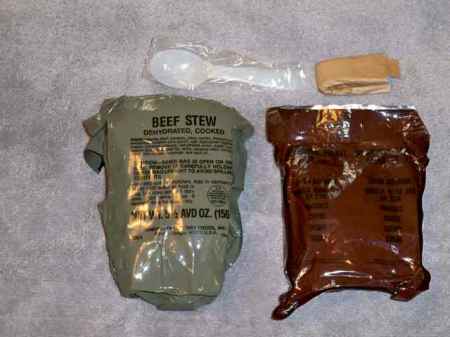
This is the official Quartermaster’s description of C-Rations used in Vietnam:
“The Meal, Combat, Individual, is designed for issue as the tactical situation dictates, either in individual units as a meal or in multiples of three as a complete ration. Its characteristics emphasize utility, flexibility of use, and more variety of food components than were included in the Ration, Combat, Individual (C Ration), which it replaces. Twelve different menus are included in the specification.
Each menu contains: one canned meat item; one canned fruit, bread or dessert item; one B unit; an accessory packet containing cigarettes, matches, chewing gum, toilet paper, coffee, cream, sugar, and salt; and a spoon. Four can openers are provided in each case of 12 meals. Although the meat item can be eaten cold, it is more palatable when heated.
Each complete meal contains approximately 1200 calories. The daily ration of 3 meals provides approximately 3600 calories.”
| B-1 UnitsMeat Choices (in small cans): Beef Steak Ham and Eggs, Chopped Ham Slices Turkey Loaf Fruit: Applesauce Fruit Cocktail Peaches Pears Crackers (7) Peanut Butter Candy Disc, Chocolate Solid Chocolate Cream Coconut Accessory Pack* |
B-2 UnitsMeat Choices (in larger cans): Beans and Wieners Spaghetti and Meatballs Beefsteak, Potatoes and Gravy Ham and Lima Beans Meatballs and Beans Crackers (4) Cheese Spread, Processed Caraway Pimento Fruit Cake Pecan Roll Pound Cake Accessory Pack* |
B-3 UnitsMeat Choices (in small cans): Boned Chicken Chicken and Noodles Meat Loaf Spiced Beef Bread, White Cookies (4) Cocoa Beverage Powder Jam Apple Berry Grape Mixed Fruit Strawberry Accessory Pack* |
The locals loved C-Rations…sometimes trading for live chickens, rice and other items and accommodating prisoners.
Individual Meals – complete
1 – Beef w/Spiced Sauce, Halved Apricots, Peanut Butter, B-1 Unit – crackers, candy
2 – Tuna Fish, Quartered Pears, Peanut Butter, B-1 Unit – crackers, candy
3 – Ham and Eggs, Chopped, Quartered Pears, Peanut Butter, B-1 Unit – crackers, candy
4 – Pork, Sliced, Cooked with Juices, Halved Apricots, Peanut Butter, B-1 Unit – crackers, candy
5 – Beans w/Frankfurter Chunks in Tomato Sauce, Blackberry Jam, Fruitcake, B-2 Unit – crackers, cocoa beverage powder
6 – Beef Slices and Potatoes w/Gravy, Pineapple Jam, Orange Nut Roll, B-2 Unit – crackers, cocoa beverage powder
7 – Spaghetti w/Beef Chunks in Sauce, Peach Jam, Cinnamon Nut Roll, B-2 Unit – crackers, cocoa beverage powder
8 – Beans w/Meat Balls in Tomato Sauce, Grape Jam, Pound Cake, B-2 Unit – crackers, cocoa beverage powder
9 – Beefsteak, Sliced Peaches, Cheese Spread, Cheddar Plain, B-3 Unit – crackers, candy
10 – Chicken or Turkey Boned, Cheese Spread, Cheddar Plain, Fruit Cocktail, B-3 Unit – crackers, candy
11 – Ham Sliced, Cooked with Juices, Cheese Spread, Cheddar Plain, Fruit Cocktail, B-3 Unit – crackers, candy
12 – Turkey Loaf, Cheese Spread, Cheddar Plain, Sliced Peaches, B-3 Unit – crackers, candy
How to make a C-Ration Stove
The small cans included in the meal were ideal for making a stove. Using a “John Wayne” (a P-38) pierce a series of closely spaced holes around the top and bottom rims of the can. This stove was satisfactory, but did not allow enough oxygen to enter which caused incomplete burning of the blue Trioxin heat tablet, causing fumes which irritated the eyes and respiratory tract. A whole heat tab had to be used.
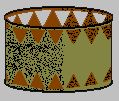 A better stove was created by simply using the can opener end of a “church key” (a flat metal device designed to open soft drink and beer containers with a bottle opener on one end and can opener on the other commonly used before the invention of the pull tab and screw-off bottle top) to puncture triangular holes around the top and bottom rims of the can which resulted in a hotter fire and much less fumes. With this type of stove only half a Trioxin heat tab was needed to heat the meal and then the other half could be used to heat water for coffee or cocoa. A small chunk of C-4 explosive could also be substituted for the Trioxin tablet for faster heating. It would burn hotter and was much better for heating water.
A better stove was created by simply using the can opener end of a “church key” (a flat metal device designed to open soft drink and beer containers with a bottle opener on one end and can opener on the other commonly used before the invention of the pull tab and screw-off bottle top) to puncture triangular holes around the top and bottom rims of the can which resulted in a hotter fire and much less fumes. With this type of stove only half a Trioxin heat tab was needed to heat the meal and then the other half could be used to heat water for coffee or cocoa. A small chunk of C-4 explosive could also be substituted for the Trioxin tablet for faster heating. It would burn hotter and was much better for heating water.
A stove was usually carried in the back pack or cargo pocket and used repeatedly until the metal began to fail.
Vietnam Veteran Keeps Vow, Eats 40-Year-Old Cake
Friday , July 24, 2009
 The Army colonel popped open an old military ‘C’ Ration can of pound cake from 1969 at his retirement ceremony, and dug in.
The Army colonel popped open an old military ‘C’ Ration can of pound cake from 1969 at his retirement ceremony, and dug in.
Moak got the drab olive can as a Marine helicopter pilot off the Vietnamese coast in 1973. He vowed to hang on to it until the day he retired, storing it in a box with other mementos.
After a formal retirement ceremony, dozens of friends and relatives joined Moak in the Pentagon’s Hall of Heroes as he opened the can to cheers. Moak joked earlier this week that he hoped the can wouldn’t explode. It let off a whooshing sound as the pressure seal broke.
“It smells good,” Moak said as he put a handful in his mouth. He jokingly staggered back a few feet and loudly cleared his throat, while one person yelled out, “Eeww, gross!”
Moak pronounced the cake “good.”
“It’s even a little moist,” he said, wiping his mouth. He dared anybody “gutsy” enough to join him, and retired Lt. Gen. Paul T. Mikolashek, who was the U.S. ArmyEurope commander when Moak served overseas, took an even bigger piece.
“Tastes just like it always did,” Mikolashek mumbled with a mouthful of cake as Moak laughed and clapped.
Moak said he wasn’t worried about getting sick from any bacteria that may have gotten into the old can, because it looked sealed. But the military discourages eating from old rations.
“Given the risks … we do everything possible to ensure that overly aged rations are not consumed,” said Lawrence Levine, a spokesman for the Defense Supply Center in Philadelphia.
Levine named the threats as mold and deadly botulism if the sealing on the food has been broken, which isn’t always visible.
Moat says though he warned his children over the years not to touch his pound cake, he did let them eat some other rations when they were growing up in the 1980s, including canned spaghetti and crackers.
And how did those taste? “Fine. Well … not like from our great restaurants.” Forty years later, Henry A. Moak, Jr., still loves his pound cake.
Everybody liked Pound Cake, but there was only (1) box per case that had it.
Thank you for taking the time to read this. Should you have a question or comment about this article, then scroll down to the comment section below to leave your response.
If you want to learn more about the Vietnam War and its Warriors, then subscribe to this blog and get notified by email or your feed reader every time a new story, picture, video or changes occur on this website – the button is located at the top right of this page.
I’ve also created a poll to help identify my website audience – before leaving, can you please click HERE and choose the one item best describing you. Thank you in advance!

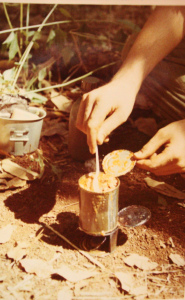






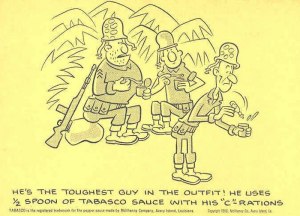

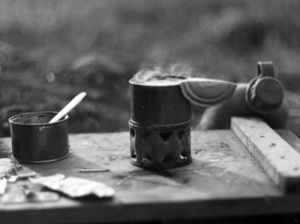

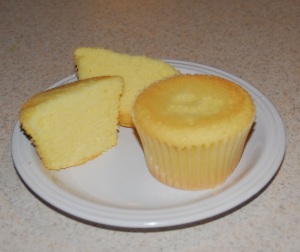

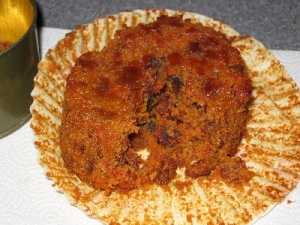

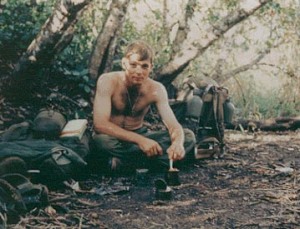

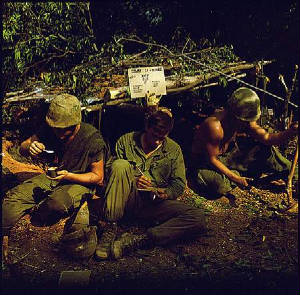
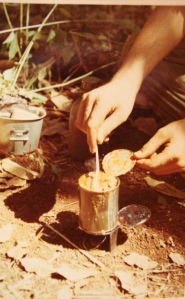


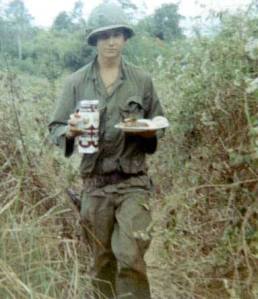

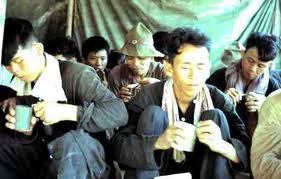


date on case of sea rations I had was Feb 1943 this was Feb 1967 the chocolate would not melt in the Nam heat used it to catch rats big ones in hooches
LikeLike
1965 I received a CRation dated 1941,4 years older than I. tThe cigarette was Lucky Strike Green. Green paint was needed for the Army so the LS “ went to war “and changed to Red
LikeLike
F-100 pilot salutes you guys who bore the brunt of the work!
LikeLike
You need plenty of Tabasco sauce, then it makes the males good
LikeLike
In the 60’s, it was Frank’s Louisiana Red Hot Sauce but did not come with the C’s. It was on every mess hall table, at least in the Army. No Tabasco cause then.
LikeLike
Nice. Served late 70’s army 25th i.d. pound cake was gold! Got out before mre’s but we were lab 🐀 s to test them. We always had our own condiments or Ramens,etc. Anything that was lite to carry
LikeLiked by 1 person
MISS YOU IRISHBULL
LikeLiked by 1 person
My c-rations in 1965 that I ate in Vietnam were dated 1945 being 20 years old ! The cigarettes were even contaminated with bugs !
LikeLike
My friend was in Vietnam and loved the pound cake. Through some investigation he found the manufacturer of it was Sara Lee. I’ve eaten both and they do indeed taste the same.
LikeLike
Excellent, brought back some good memories.
LikeLike
I so enjoyed this story!
LikeLike
Semper Fi. Dan DMZ M/co 1969 USMC Hill 461 Sieara Rock Pile , Stud, LZ MAC … chopper down!
LikeLike
Took me back,soldier. Smiles…nada but smiles.
LikeLike
Remember chunks of pork with an inch of grease on top. Almost never saw heat tabs , we called them c tabs they didn’t want us to have flames. They came sealed in foil . On rare occasions when allowed piled stones put tab in middle for stove. Did not see mention of toothpick that you chewed one end for toothbrush ( sucked).
LikeLike
Very well written and important for us who did not serve due to age ( too young) to learn about this
LikeLiked by 1 person
Excellent;
Broight back some memories for me from my year in the bush.
Currahee
LikeLiked by 1 person
Grab a small loaf of bahn-mi or baguette from the village baker with a can of boned chicken gently heated on the V-100 manifold…That and a ‘ba-moui-ba brew…not bad.
LikeLiked by 1 person
I’ll never eat C-Rations again, but I can remember when I was glad to have them.
LikeLike
I served in Co. B, 1/12th, 1st Air Cav I 1967-68. As an infantry unit our year was pretty much the same as yours. In the field 90% of my tour.
The section on C-rations brought waves of memories of those days. Toilet paper and mosquito juice in band on our steel pot to keep them dry. Meatballs and beans! A combination my Italian wife would cringe at.
Anyway, you made my day this morning. And at 75 years old, that’s a blessing.
Thanks again.
P-38! Haven’t heard that in eons.
LikeLike
Was in army boot basic in 1980 Jan I Remer those c and b rations still have my P38 on my Dog tags from boot camp
LikeLike
I always enjoyed the the canned biscuits
LikeLike
Brought back lots of memories. Love the pound cake especially if you saved the fruit cocktail and ate them together. You did a great job with this.
LikeLike
Great 👍 thanks
LikeLike
We had C Rations to eat while in the Pentagon Oct 21st 1967 while the war protest march was going on. Only hot meal was the last morning for chow.
LikeLiked by 1 person
In 1968-69 I ate c-rations that were older than I was.
I lived on peaches & pound cake for breakfast with hot chocolate.
LikeLiked by 1 person
How did you get that much peaches and pound cake? Rat fuck the cases?
LikeLiked by 1 person
Now I’ve heard a lot of BS from Nam Vets, but this is one that is Truly BS. Why don’t you explain to us Nam Vet how you accomplished that.
Currahee 3rd Bn Abn 67-68
LikeLiked by 1 person
I notice in the list of individual C-Rat meals some mentioned I never had in 67-68. I suppose because what we had was from an earlier time. I also notice that noone ever mentions the Chiclets that turned to little pieces in your mouth if you chewed it for to long.
Currahee
LikeLiked by 1 person
Brings back memories of a distant time…..
LikeLiked by 1 person
I ate a year’s worth 199LIB 11b20 September 69 September 70
LikeLiked by 1 person
Great. I was an US ARMY Veterinary food inspector from 1967 to 1987. I was the in house inspector at Granite State packing from 72 until 75. This establishment made Beans and Meatballs in Tomato Sauce shipping thousands of cases a month out. It was a great job. Very interesting.
LikeLiked by 1 person
You brought back a lot of memories. Well presented and will share with fellow Vietnam veterans and family. Most of us knew there were others who had it harder than than we did. As a Army pilot, I knew this well. There were times I ate the C’s and the dates were from the Korean years.
LikeLiked by 1 person
I flew as a Crewchief on a UH-1C Gunship. We never had cold meals. When we shut down to eat we would use our really long pliers to hold the meal as the ship was running down. It would swell up and we wood take it away from the exhaust port until it went back to it’s original size. We would do the same process one more time and it would be ready to eat after you wiped it down to get as much black exhaust crap off and open it with your P38.
For the new guys flying for the first time, we never let them know how to do it. Lots of exploded food and they had to clean up the tail of the ship. That went for Officers and enlisted men.
LikeLiked by 1 person
Funny story, Buzz. Always let the FNG’s learn a lesson the hard way. We just heated ours with a ball of C-4, i.e., after opening the can.
LikeLiked by 1 person
Great article, I was USMC 1966/67 Vietnam. As I remember our C rats were marked 1941 &42. I think I was one of a few who actually liked ham and Lima’s. So many times I got something other that ham & Lima so I made out in the bargain department.
LikeLiked by 1 person
This brought back memories from 68-69 in the jungles of the central highlands. C-rations and m-60 mechine gun and GOD are what got me through tough times . 4th infantry
LikeLiked by 1 person
Great article. Remember c rats well . I was a cold war veteran spending my 3 years in Germany, but we were issued them for field trips, alerts and exercises.
Hated Ham and Lima beans
LikeLiked by 1 person
I too was in Berlin during the cold war. We went through East Germany on the Autobahn to Holiefield’s in Weat Germany for a training mission. On the way we had C-Rats, I liked the Ham and Lima beans, they were easy to trade for as a lot of guys like you did not like them. The brothers always would trade for Menthols. While on this maneuver I celebrated my birthday by having grape jelly with my pound cake.
LikeLiked by 1 person
Excellent !! Brings back a lot of memories. Always enjoyed the meals when I was out in the field. My favorite meal was SPICED BEEF and GRAVY with crackers and cheese.
Everyone’s favorite dessert was PEACHES and POUND CAKE. We called our can openers a JOHN WAYNE or P38 it had a small hole in it and we would put it on our dog tags.
USMC 2/9 DA NANG , DONG HA,
PHU BAI, CAMP CARROLL, NAM 66/67
LikeLiked by 1 person
GIT SUM
LikeLike
While serving in the Central Highlands with the 1/12th Inf. We had would get rations of beer and soda dropped off often in the jungles. A few of the troops didn’t like to drink beer. I would save my fruit and pond cake and trad for their rations of beer. I would have beer almost every day. It got to taste good warm after you got used to it.
LikeLiked by 1 person
I got to Vietnam in July 1967. The 1st Inf Div was not allowed beer in the field due to some previous incident. Thanksgiving and Christmas 1967 saw one beer per guy allotted to the troops.
LikeLiked by 1 person
It was just what I needed. Thank you so much. My dad died in Vietnam in 1965. I was 13.
I’m writing a book which is fiction loosely based on my real experience for ages 10-14. I just put the pound cake into one of my scenes.
I’m also interested in the mail service during this time period. My story is written in letter form with letters to the characters’ father, to Walter Cronkite and to some other people.
LikeLike
Hi,
Thanks for this article and thanks all American officers and soldiers in the field of VN war. Even though America gov. Abandoned my country, Vietnam, in 1975, but that did not make me hating them. Of course it was not their faults, soldiers , at first and second to be fair they needed to go home with their families.
Ah! Yes I remembered those olive canned food because my dad, VN’s regime Officer before 1975, let me tried > canned of chocolate in foil, cake, peach, M&M, shredded pork ( ? it seemed like that to me :)) , and shredded beef ( per my visual to call it as such) . Actually, I has been liking and still remember those good smell and tasty of those Military canned food. I , however, could not find its same taste and flavor in America 😦 after 30 years in USA. I’ve been missing those Olive can food image and its opener tool. My dad knew few young kind and handsome American colleagues that I admired and impressed at that time. Silly me ! Right?
LikeLike
Sir, thank you for your service in Vietnam and for the insightful information you provided in this article. I was on Google looking up information on c-rat socks as this is a new term that I just learned and that is how I arrived here. I am a VA RN and a volunteer wildland firefighter / EMT-B. In the fall of this year I will be in a paramedic program. And one day I plan on working as a flight RN / EMT-P as well as continuing to either work or volunteer as a firefighter. I considered serving with the US Armed Forces on countless occasions however I have an old skateboarding injury in my foot and ankle and hardware that came with it that ultimately made me decide to serve domestically. I explored the possibility of having the hardware removed and obtaining a medical waiver, but the consultation I received from docs and my own inner wisdom left me deciding on the path I am currently on. The dream of being a SEAL, US Marine, PJ, Delta, Recon, and the like is still very much alive within me to this day. God bless you and I hope that this note finds you well, Sir.
LikeLike
Good article. I want to thank all the men and women who served in Vietnam. I got my first
taste of C-rats in 1975 in basic training at Fort Polk La. At the time no one wanted the egg
meal eggs always looked greenish . Every thing else not to bad. The next thing I got was the MRE’s. Not to bad either!
LikeLike
Good i was there at that time 70 71.
LikeLike
Good i was there at that time 70 71.
LikeLike
Oh, the memories….
Beef and Rocks, Scrambled Rubber Eggs, Chili, Applesauce, and Shit Disks.
I was there during the transition from C-Rats to MREs during the early ’80s. And in spite of all their faults, I do sometimes miss C-Rats, especially the Pound Cake!
LikeLike
1st tour grunt recon, etc. Only once was stupid enough to eat the WHOLE LRRP ration at onne, swells up pretty big after the water goes down! 2nd tour, NO problem, LOACH pilot and home every night if I didn’t get shot down! ;~)
Scottie Hill CW4(Ret) Ret. Gun Pilot
LikeLike
B3, the co co package. We would either just add sugar pack and eat. Today still add sugar to store hot ccco mix and eat it. Also sometimes we added the sugar, creamer, and coffee park in the coco package adding a little water mixing it up. We called it Coco mo. Close to Mom!s chocolate cookie mix before she put on the cooking ban to bake. Fox 2/7 Marines 0311 June 1969/June 1970
LikeLiked by 1 person
Got to Nam in July ’68 an assigned as a pilot way down in the Delta. We were at the end of the supply line so we ate a lot of C-rations. My two favorites were “green eggs and ham” and yes, ham and lima beans. Often got C’s that had been packaged right after the Korean war. Got some Phillip Morris cigarettes in a dark brown package – PM quit using the dark brown package in the late 1940’s – that’s how old some of the C’s were.
LikeLike
Living in Florida, for years I kept a couple of cases of C’s on hand as part of my hurricane supplies. Don’t have any C’s any more, but still got several P-38’s, three still sealed in the brown paper. Last time I tried to replace my C’s the price had gone out of sight. So I gave my last C’s to a Boy Scout Troop and switched to freeze-dried packets (civilian version of MRE’s) . I liked the C’s better.
LikeLike
Going through a box of memorabilia a couple days ago. Found four P38’s still in the brown paper wrapping that I brought back from Nam in Dec. ’72.
LikeLike
After a short naval round almost blew us away, I smoked too many of those Lucky Strike four packs and suffer today as a result. I wish that cigarettes were never part of those C-rations.
LikeLike
My father used to grumble about C-rations from his service in WWII, also, so it was interesting to read this site. As a historian, these are important details as even food technologies change.
And to you Vietnam soldiers—welcome home sincerely wished to you all. You did what you had to do and made it home to an undeservedly rough reception. Stand tall and thank you for your service.
LikeLike
Our company left San Diego with a Navy Band giving us Marines a memorable send off. Returned 13 months later via Tiger airlines to a civilian air port in LA & greeted by a lot of people flipping the bird at us. Three of us hailed a cab & that older gent stopped & bought us a six pack. Glad to be on my way back to Goliad, TX — so many of my buds were not so lucky. Semper fi !! Tellander Sgt USMC
LikeLiked by 1 person
I have an entire case of unopened C rations from 1969 for sale on Ebay right now. Trying to spread the word to potentially interested people. Thank you for your time. Kevin.
LikeLike
Ha, ha! I was the lucky one that LIKED ham and Lima beans! I never went away hungry!
LikeLiked by 1 person
There was a reason they were called Ham & Motherfuckers. My last CO also liked them. When absolutely necessary, I’d empty the water and spoon in a can of cheese, melting it together with a ball of C-4.
LikeLike
Thank you for taking the time to write this article. I was barely more than a toddler during the Vietnam war, and am a non- veteran. But I read as much as I can get my hands on about what it was like to have served in those times. I appreciate the education you help to provide and for keeping it real for those like myself who have never had these experiences. You, and all veterans have my utmost respect and admiration. I thank each of you for all you have done and all the countless sacrifices you made. Kindest regards.
LikeLike
We sometimes ran out of C-rats, especially when we couldn’t get resupply because the runway on our LZ was damaged by mortar attacks. At times we actually had to buy cases of C-rats in Phan Thiet where there was a thriving black market. You could buy cases of beer and soda too. (Obviously some supply sergeant made himself a bunch of money.) My favorite C-ration dish was created as follows: 1.) Open can of peaches with P-38. 2.) Pour out all of the heavy syrup, and 3.) Replace with VO or whatever whiskey you can find. 4.) Enjoy!
LikeLike
Excellent piece and very true in every respect. Thanks for summing up all the C-ration experiences. It does take one way back.
LikeLike
On the tug ” Agnes Foss ” we hauled a lot of C-rations around the coast and up rivers. Barges were loaded with ammo and stores
LikeLike
I especially like the little flecks of OD paint mixed all through the food from opening the can with your P-38. Years later I wonder if the paint was lead based? It would explain a lot of the stupid decisions I’ve made over the years
LikeLike
Interesting article but a really dumb question? Since your audience is mostly ‘nam vets, I’d guess ALL OF THEM “remember c-rats”.
LikeLike
I was with the First Air Cavalry, (67-68) when we moved the whole division from An Khe to what eventually became Camp Evans, (we called it Tombstone, because we were camping in a Vietnamese cemetery) The first brigade of the 101st Airborne was under the operational control of the Cav at that time. We were the first army division in the first corps at that time. I remember that there were no hot meals and you learned the hard way what each unit in the box contained. We were supplied by air drops and you ran to the pallet to get the best c ration unit. That was the beginning of the Tet Offensive and the hot meals were few.
LikeLike
I delivered beer to you guys. 98 the LEMCO Cha Rang Valley ’66 ’67. At An Khe and Bong Son.
LikeLike
needs p38 please, thank you!my last original.took leave three yrs ago..jeep became stolen
recovered jeep. 10 days later gulfort, mississippi..
still crave C’s
jus lemme have a p38..
General Delivery Silver Springs Fl.34489 USA
Semper Fidelis
LikeLike
Give me an address and I’ll send you one.
LikeLike
I got a flashback I’ll never forget those days Sometimes I would eat the pineapples, bananas or coconuts if I could get them. I will always remember that time 1967-68
L/Cpl P.T. Smith Bravo Co. 2nd Plt 1st Bn 1st Mar Rgt 1st Mar Div
LikeLike
Old memories
Don’t forget to stir before putting over fire. I have a few fng stories about Cs
LikeLike
It is OK
LikeLike
About C-Rations. My favorite was, Ham & Eggs Chopped.
LikeLike
That was like eating the congealed fat from a canned ham.
LikeLike
Very informative and well written,
LikeLike
I ate C rats in Korea in 1960-61, and in Vietnam ’65-’66. Most of them were manufactured the year I was born, or the next after. I agree almost entirely with you assessment of taste and quality and preferences, with one exception: I was a combat photographer with the First Air Cav, and made it my personal mission to photograph an op from each of our original 8 infantry battalions , all of our artillery battalions, and the engineer and cavalry units, plus every company in the Aviation brigade. Never saw anyone eat pound cake without spitting it out. It’s chief use was to hold several ounces of insect repellant, which we then set afire and used in place of a heat tab, which were in short supply. Thanks for your interesting accounts, and for your service. Marvin J. Wolf, author of “Abandoned In Hell, The Fight for Vietnam’s Firebase Kate.”
LikeLike
Great article…brings back many memories of the “bad old days”. I was with the 173rd Airborne/2ndBn 503rd Infantry. We had the dubious honor of being the first Army ground unit deployed to VN in early May of 1965 from Okinawa and all enjoyed consuming our fair share of those gourmet C rations. Pound cake was one f the favorites in my platoon. We would punch a few holes in the top of the can using a P38 and add a small amount of water and heat it for a bit with a piece of C4. It tasted like delicious warm and moist cake fresh from the bakery,
LikeLike
Great walk down memory lane. Old wolfhound here…A/1/27…….66,67,68……..no one mentioned the hobo stove which when out of heat tabs or C-4 we would open a can of peanut butter. Then mix a bunch of mosquito repellent in about a half of can….use the rest of the peanut better on the very thick (hard tack) crackers!! Once lit it would put out a decent flame……..my favorite was spiced beef….but had to be served hot….cold it sucked.
Our squad leader was fair…turned all C’s upside down and would mix up…..then we would pick…..No Fear!!
LikeLike
Thought it was really good. Missed the initial one 4 years ago
LikeLike
Wow brings back a lot of memories. I lived on pound cake and chicken noodle soup cooked with a pinch of C4. Sorry 11B’s I always took my favorite out first. I was a crechief on Hueys who resupplied you guys. I have the greatest respect for the grunts they did it with ingenuity and a lot of common sense. Welcome back.
LikeLike
Reblogged this on Cherries – A Vietnam War Novel and commented:
Here’s a blast from the past…a favorite article by visitors posted over 4 yrs. ago.
LikeLike
Just took me down “memory” Lane
LikeLike
I found this very interesting
. I wanted to see the reality of what the soldiers had to endure. I have so much respect & admiration for them. Patrick Douglas Erb was there from Oct.20,1970-March 15,1971. Helicopter Pilot. Warrant officer. Crash fire. From Sylmar, CA. I wanted to see more of his brave journey. A generation full of Peace&Love did not belong in Vietnam ever! Miss those soldiers from our lives deeply. 💔
LikeLiked by 1 person
Just looking at a can of Ham and MFers makes me wanna puke. I always wanted or traded for boned chicken or turkey, because if I remember correctly they were made in Saint James MN. Being from MN was my home connection
LikeLiked by 1 person
I liked ham and limas. What is wrong with me?
LikeLiked by 1 person
Hey… me too… other good ones were Beans and Balls… Beans and Dicks… Beef and Potato… couldn’t eat the egg thing… spaghetti could not be cooked in the can, it would just rise up as a blob, cold top and burned bottom… I’ve got peaches, who’s got the pound cake…
LikeLiked by 1 person
I saved my ham & lima beans until we returned to the rear, then put the on the stove, boiling hot with a little hot sauce made me happy
LikeLike
Wow, how did we survive. I got out of the field with 12 days left and went to Song Be. While there me and a buddy were starved one night so we go to the helicopter pad and find loads of empty cases of c rats, we start searching after about 10 minutes my buddy finds a can, lights up his zippo and with his southern twang says Michael, I can’t hardly believe someone left a can of ham and M F ers behind. (Ham and eggs) they were the worst.
Great site thanks for the memories. I also still have my P-38
LikeLiked by 1 person
Ham and eggs were definitely the worst….with the consistency of the congealed fat from a canned ham but ham & mothers referred to ham & lima beans. My last CO loved them.
LikeLiked by 1 person
Spot on, thanks.
LikeLiked by 1 person
Ron Perron
Had to have Tabasco sauce for the C rats. Loved the lerps when we could get them. Every once in awhile they would send us out real food and some Beer and coke. Saved the coke for when we would be by the tanks or APC’s. took the fire extinguisher and use it to get our cokes cold. Loved the article brought back a lot of memories.
LikeLiked by 1 person
In Thailand, sriracha sauce was even better than Tabasco.
LikeLiked by 1 person
Where can I buy this rations ?I like this food too much.
LikeLiked by 1 person
Your website really help me and my grandson doing a paper on me. Great detail Great Job from an old army Grunt. We got a hot meal in the jungle only after a firefight. Once I got some pancakes that had been stuffed down an elephant rubber. Tasted like TNT from the powder charge. They Tried! Thanks Freddy Wright
LikeLiked by 1 person
Welcome Home Brother!!!
LikeLike
Hey, I think your website might be having browser compatibility issues.
When I look at your blog in Opera, it looks fine but
when opening in Internet Explorer, it has some overlapping.
I just wanted to give you a quick heads up! Other then that, fantastic blog!
LikeLiked by 1 person
Cut the canned roll in half, spooning the can of cheese inside, put back in can, fold over the can top, put back in c-rat box and light the box on fire. Voila…toasted cheese sandwich.
The absolute worst, in my opinion, was the “ham & eggs, chopped”. It tasted like the congealed fat from a canned ham.
LikeLiked by 1 person
When I had my first taste of LRP Rations …I thought it was food for angels. It was great when someone got a care package from home……we all shared.
LikeLiked by 1 person
Very nice, brings back memories, thanks
LikeLiked by 1 person
Hi mates, good paragraph and fastidious urging commented here, I am genuinely enjoying by these.
LikeLiked by 1 person
I did 3 tours 69-71 with Army artillery..Our 1st c rats were stamped 1946 and tasted no differnt than those made in the 60s..Beans and Weenies all the way!
LikeLiked by 1 person
Back in 1958 while flying the Pacific we had only C’s for flight lunches on aerial Tankers. Used to put them on the voltage regulators to heat. Never told 2nd Lts about the hazards of heating an un-opened can. They learned quickly when the cans exploded and “Messed up my airplane” said the M/Sgt who was the flight engineer sitting across from the voltage regulators. Nate Hill, Pres, TAC Tankers Assn.
LikeLiked by 1 person
Man do I remember C rations. We would get a hot meal maybe onced a month. But it was usually raining. So the food on a paper
Plate. Would turn to soup. With the water pouring down on us. Back
To eating our faithful C rations.
Staf Sargent Larry Bailey.
LikeLiked by 1 person
I carry my P38 that i had in Vietnam on my keychain. Never know when you may have to open a can of crackers!
LikeLiked by 1 person
We burned and buried the last ones in the system in1986 in the Sinai desert. The Food Service Officer (Canadian Major) thought she got a deal on them. We, the Army Inspectors, condemned them all.
LikeLiked by 1 person
Greg Dearborn says:
Nov 16, 2013 at 2338hrs
Being an MACV Advisor C-rations always tasted good when ever we had a chance to beg some. Beat the heck out of what we scrounged up to eat with our counterparts. We always had plenty of rice. TM 21 1965
LikeLiked by 1 person
MACTHAI advisor here. The local food in Thailand deserves its stellar reputation.
LikeLiked by 1 person
The VC had no heart pinned down one day took out my last
fruit cocktail about to down it and a 60mm blasted my can out
of my hand did not care about cut hand But mad till this day
about fruit cocktail.
LikeLiked by 1 person
Pound Cake and Peaches were my favorite, Sometimes the VC beat us to the C-Packs when they were dropped in the jungle by chopper.
C-packs also contained cartons of Cigaretts, M&M’s and other favorites,
Tay Nihn…………..68 Nui Ba Din
LikeLiked by 1 person
Agree pound cake slice it mix choc sugar creamer make icing. Everyone like cake after that.
Left the nam brought one home should have seen the looks I got.
These were the times that made it ok. Sitting in a bunker with a m60 in the monsoons I try to forget. I miss the guys I hope all are doing well.
LikeLike
I thought that smoking American cigarettes was a big mistake. Smoking the local product might fool Mr. Charles.
LikeLiked by 1 person
That must have been devastating Joe!
LikeLike
I really enjoyed Meat balls & beans. It`s the meal that had the pound cake. Spent almost 2 yrs in Northern I corps. Welcome Home my brothers & Sisters. Semper Fi
LikeLiked by 1 person
Left out the crew chief version of a stove. Open the cracker can leaving the lid attached, fill half way with dirt, then drain some JP-4 from under the Huey in to the can. Move away from the Chopper and light with matches from C-rat. Balance food to be heated on bent over lid and can while fire heat main course.
LikeLiked by 2 people
Never heard of that version before. Must have been super hot…
LikeLiked by 1 person
This isn’t Larry Craft from Pittsburgh, is it?
LikeLike
Larry, as a young WO1 pilot just reporting to Nam, making and using the “crew chief stove” was one of the first thing my crew chief taught me to do. To you and to all the crew chiefs and gunners, from the bottom of my heart, I say thank you. You were the unsung heroes of Army aviation.
LikeLike
LRRP rations were much better than C’s.
LikeLiked by 1 person
The military teaches you to be a thief . I got pretty good at stealing C4 to cook with , and those LRRP rations . They were pretty good .Carried a container of onion salt , and garlic salt for the C rations .
LikeLiked by 1 person
All those you show here was my usual meals at the jungle in Vietnam
LikeLike